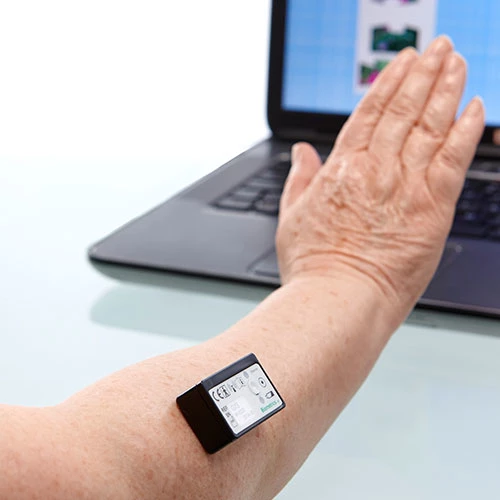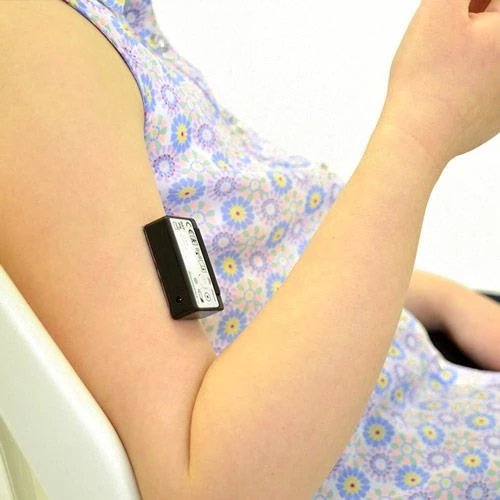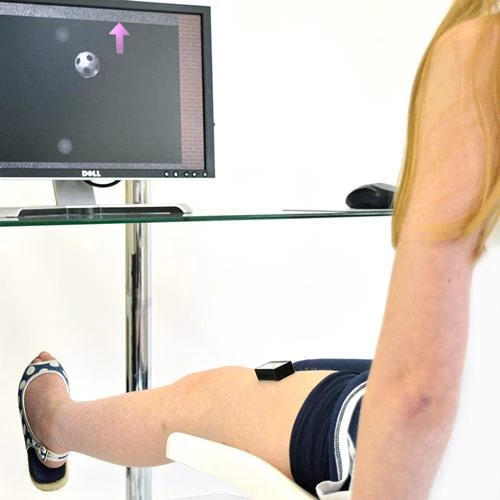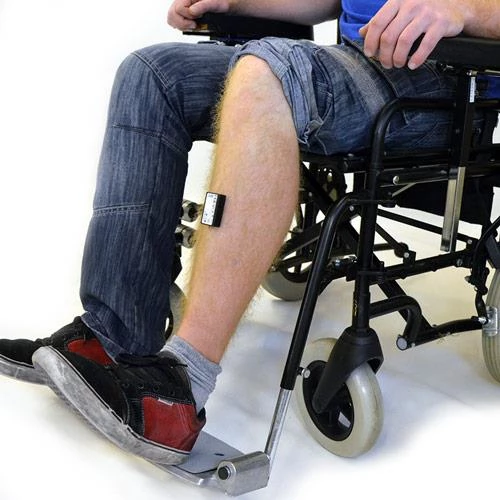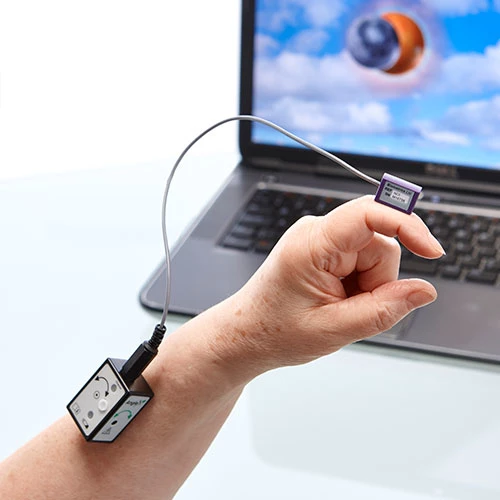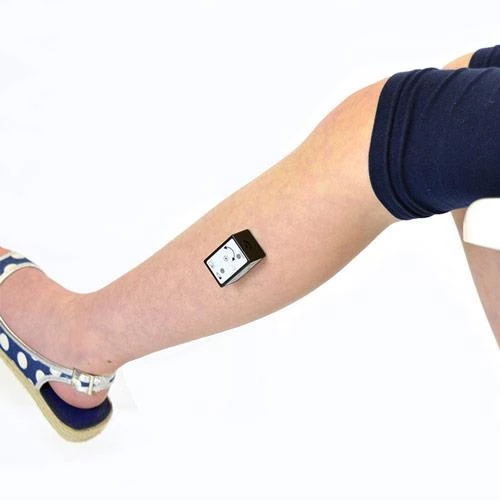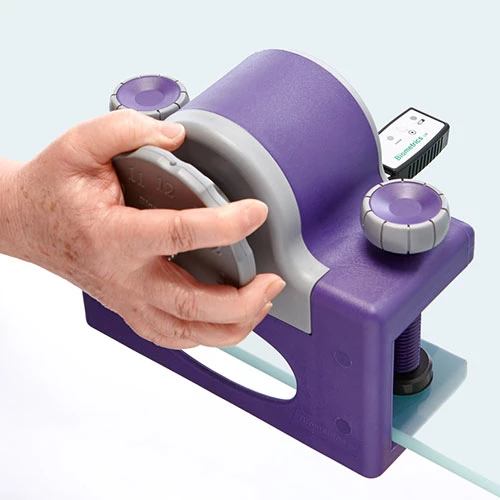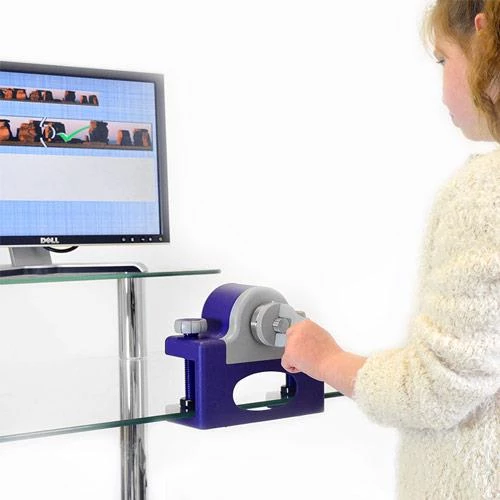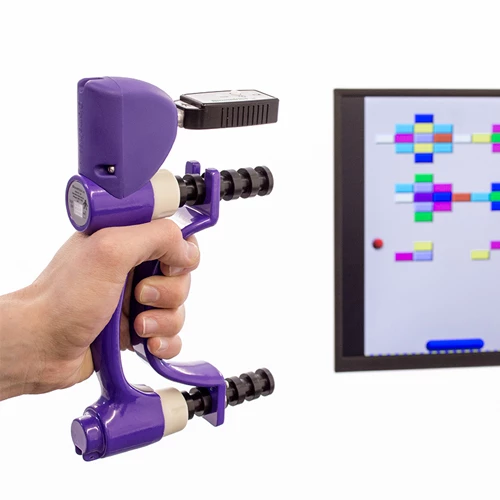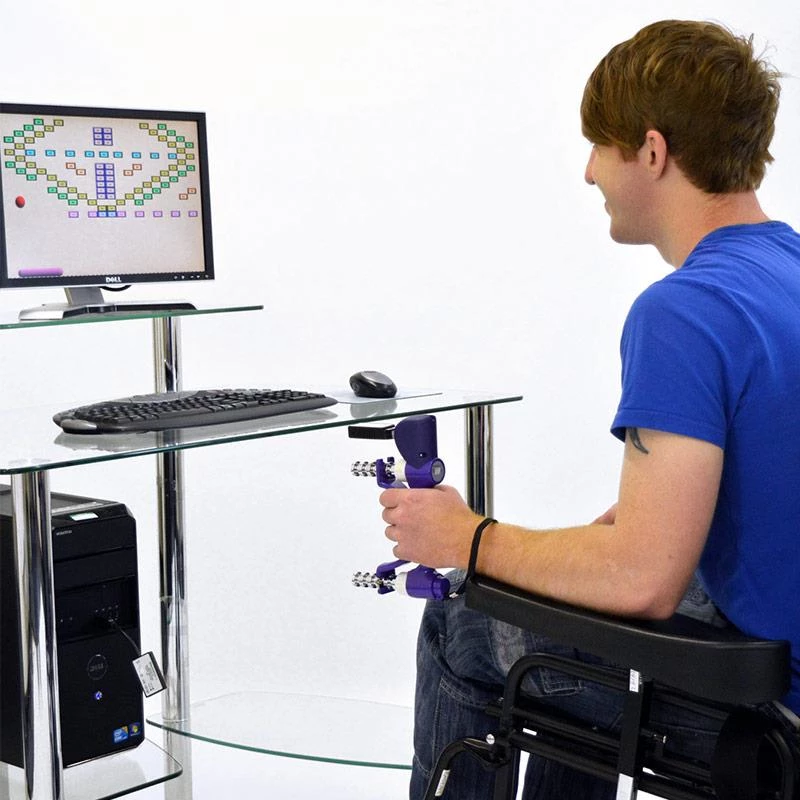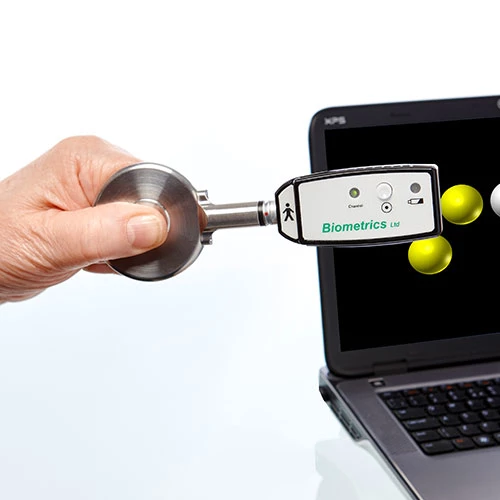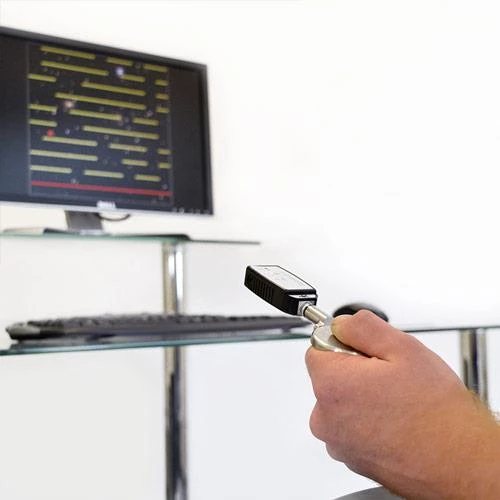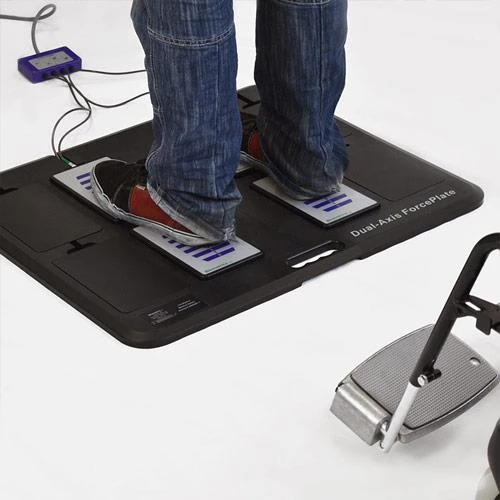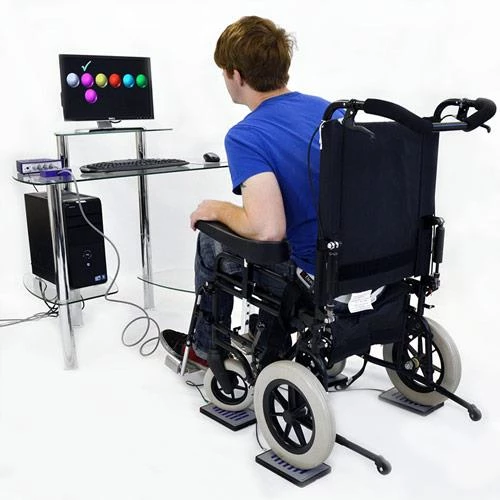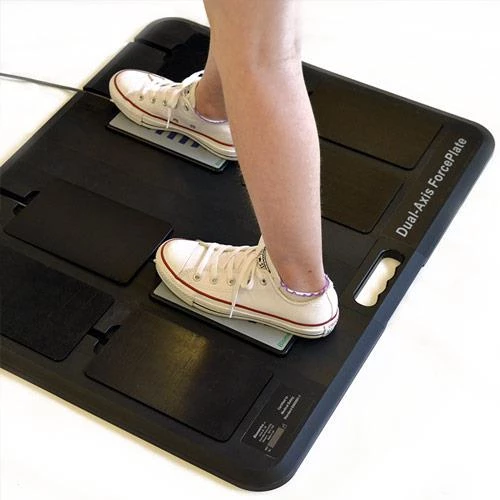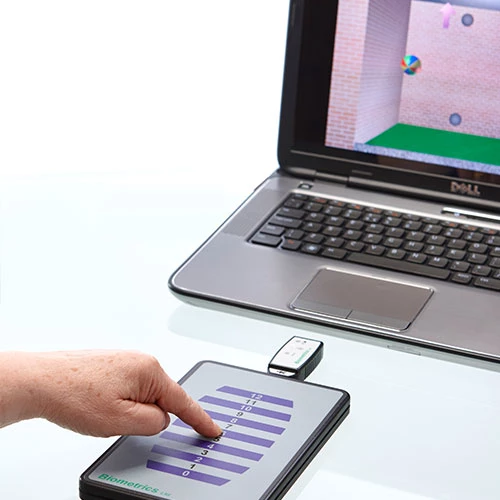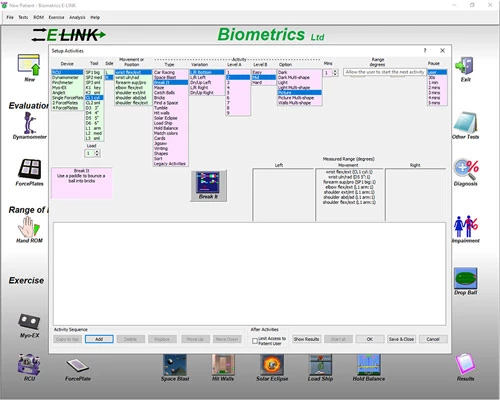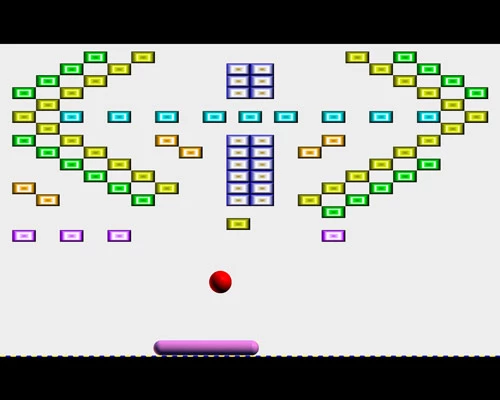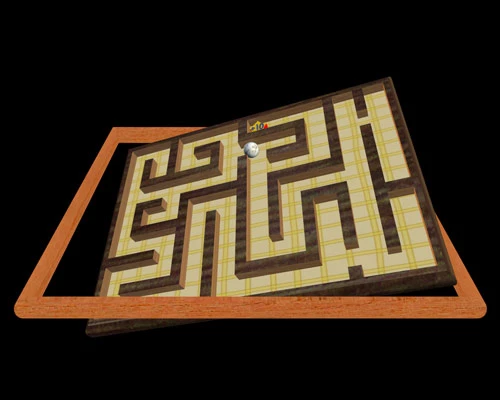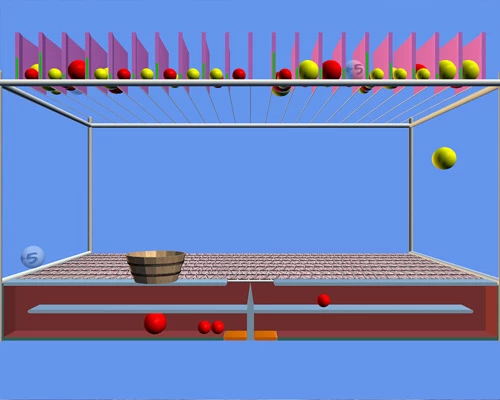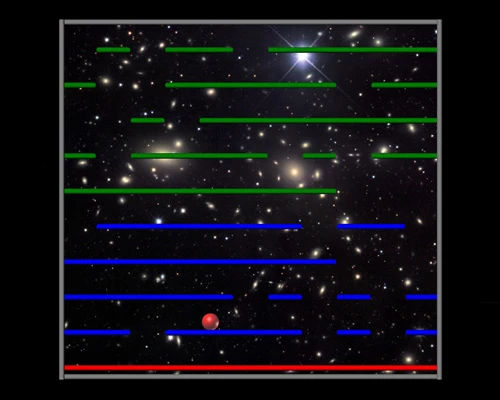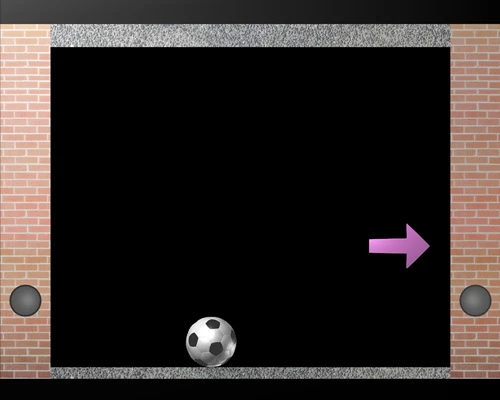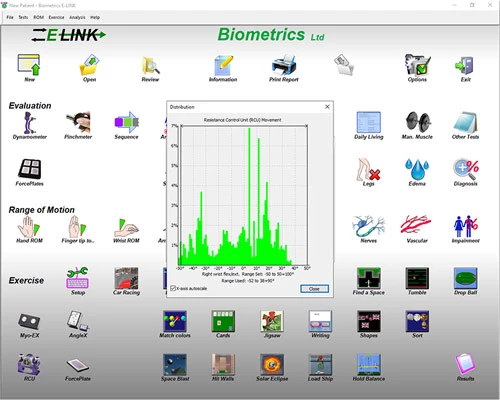Innovative Exercise
The most important therapies are those that help patients live their everyday lives and physiotherapy and occupational therapy give particular focus to improving mobility and strength as these are fundamental to independence for the patient.
E-LINK is ideally placed to be utilized for these goals throughout the full rehabilitation process from acute settings to long term care as needed. Various devices, combined with gradable Activities, encourage muscle strengthening and restoration of normal movement patterns through functional exercise.
The ready to use Activities incorporate a fun element into each therapy session, maximizing the patient's motivation to exercise as well as addressing various cognitive and perceptual issues.
E-LINK Myo-EX
For the neuro patient who has very little or even no visible joint movement, exercise can be undertaken by using the unique Myo-EX sensor with innovative computerized Activities.
The sensor excitingly detects very small flickers of muscular activity and, using surface EMG, provides immediate biofeedback to the patient through the visual movement of objects on the computer screen. To score in the Activity the patient is encouraged for instance to match colored objects correctly or hit a football against a wall and hold the ball on the wall for a determined length of time or place jigsaw pieces in a puzzle. In order to succeed, the patient is focusing effort on a smooth, efficient and co-ordinated movement rather than recruiting possible unnecessary compensatory ones.
- Myo-EX is ideal for wrist and elbow exercise, focused exercise on the shoulder musculature, knee and ankle exercise and has even been used with certain facial muscles
- Biofeedback is immediate to the patient through the movement of objects on the screen providing a high degree of motivation for exercise
- The precision sensor is designed to give superb quality of signal and can detect as little as 3-4 microvolts of electrical activity
- Full scale reaches up to 3000 microvolts for working with larger deltoid, bicep or quad muscles
- Simply placed on the skin surface over the muscle to be exercised the Myo-EX sensor is quick and easy to apply, with little to no skin preparation, and is ideal for using in various clinical environments, from the bedside to out-patient clinics
- For additional benefit the wireless sensor gives greater freedom of movement - there are no wires to potentially trap in wheelchairs or the patient may even be positioned some distance away from the computer, for example when using a large walled viewing screen
- Myo-EX – ideal choice for focused exercise
Mini Case History #1 - Using the Myo-EX
Neuro Rehabilitation - Mini Case History #1
From a Community Hospital in the Midlands
From the Therapist – "I would like to take this opportunity to tell you of one of our very satisfied users of E-LINK, in particular the Myo-EX. Mr S is a 22 year old who we saw following TBI. He was previously very fit and active. He utilised a wide base of support and flexed posture for stability in sitting and during mobility. He struggled to raise his eyes from the ground due to his posture. Cognitively he struggled with insight and awareness and had a very poor short term memory, therapy sessions had little carry over, particularly if the exercises were not in a functional context. However in functional activities his alignment and tone were far from ideal and he struggled with verbal or hands on direction to improve this mid task.
He agreed to trial the E-LINK. Our aim was to improve postural awareness and work on scapula setting. Within 10 minutes the visual feedback he received from the system enabled him to activate consistently and achieve both active pelvic tilt and scapula retraction. We moved forwards until we were using the Myo-EX on Posterior Deltoid alongside a light hand weight whilst seated on a gym ball. This contributed significantly towards narrowing his base of support when mobilising. Most importantly to him he felt like he was 'exercising' rather than 'receiving therapy', a bit step towards him returning to the gym.
Not only this, due to the gradable nature of the E-LINK games we were able to address a variety of perceptual and cognitive skills, (most significantly for him, scanning and processing speed), without paper based exercises or therapy games, to which he objected. He is not alone in benefitting from the Myo-EX for scapula setting. It remains our most successful method of raising awareness in scapula control, we can achieve more in 1 session than in several sessions using alternative methods."
Mini Case History #2 - Using the Myo-EX
Neuro Rehabilitation - Mini Case History #2
From a Stroke Unit in Scotland
From the Therapist - "I have been using the Myo-X with a young chap with an undefined neuropathy. He had a stroke in 2007, regained his function, but remained aphasic and only had the use of his left hand, but after becoming severely ill in January this year, he lost the power in the remainder of his body and was completely dependent.
Recovery was minimal, and work between February and May saw an improvement in his left shoulder and elbow with a very slight wrist improvement. However, after one session with the Myo-X, a significant improvement was visible and he was very pleased. He was able to stabilise his wrist to a greater degree than anytime previous. Now, strength rarely appears miraculously and what I think happened is that the Myo-X taught him to find and isolate the movement in one session, and made him stop recruiting unnecessary movements of shoulder and wrist. It was a great result in a very short space of time and we continue the sessions."
E-LINK AngleX
Where joint movement is observed but is insufficient to grasp or hold a device, AngleX sensors are just the thing to use for every stage of neuro rehabilitation. They are simply attached close to the joint to be exercised and respond to active movement against gravity, providing focused exercise for gross motor control through to the finer movement for even a small DIP joint.
- The small AngleX is used for the fingers, thumb and wrist
- The large AngleX is used for the forearm, elbow, shoulder, hip, knee and ankle joints
- AngleX encourages normal patterns of joint movement and discourages compensatory ones
- No preparation needed - simply apply to clean, dry skin using medical grade tape provided
- Baseline readings are taken in 1° increments for the patient's comfortable ROM and automatically entered as the range for the chosen Activity
- Each Activity has many options to grade the game to meet the precise goals that suit each individual patient
- AngleX is ideal for focused joint exercise of the upper and lower extremities
E-LINK Upper Limb Exerciser
If the neuro patient has sufficient grasp to hold items, the Upper Limb Exerciser with various tool handles is perfect for functional, repetitive active exercise.
- The Upper Limb Exerciser is just right for active and active resistive exercise of the fingers, wrist, forearm, elbow, and shoulder
- Baseline measurements of the patient's comfortable ROM are taken and automatically entered in the Activities chosen for exercise
- The range can be set to as little as 2° ROM enabling exercise for the patient who has very little movement and gradually graded over time through to an optimal range of motion
- The resistance can be adjusted and graded according to need throughout the full long-term rehabilitation process for progressive muscle strengthening exercise
- Realistic goals can be set and achieved at the patient’s own pace , addressing specific therapeutic objectives
- Most importantly, it is simple to set up and quick to use - ideal for busy units, therapy groups and outpatient clinics
Mini Case History #3 - Using the Upper Limb Exerciser
Neuro Rehabilitation - Mini Case History #3
From the Therapist
Using the Upper Limb Exerciser - From the Royal Hospital of Neuro Disability London
John, a 35 year old male had a TBI which left him severely physically disabled. He was able to express a wish to use the Nintendo Wii for leisure, but was unable to abduct his shoulder sufficiently to allow enough arm movement to use a Wii controller.
The occupational therapists used the Upper Limb Exerciser to build shoulder range and strength, which enabled John to use the Nintendo Wii more efficiently with a view to participating without the need for adaptation in the future.
(Published: Occupational therapy to facilitate physical activity and enhance quality of life for individuals with complex neurodisability. Cunningham, Crystal; Wensley, Ruth; Blacker, Danielle; Bache, Jane; Stonier, Claire. The BJOT, Vol. 75, No 2, Feb 2012, pp.105-110)

E-LINK Dynamometer and Pinchmeter
As the neuro patient progresses through the rehabilitation process, formal evaluations of grip and pinch strength can be assessed and monitored with the E-LINK Dynamometer and Pinchmeter which are accurate, sensitive devices, registering as little as 0.1kg/lb strength measurements.
Immediately following a precise evaluation, the Dynamometer and Pinchmeter are perfectly placed for unique isometric exercise in order to maintain or improve functional muscle strengthening goals.
- Each patient can work to their baseline measurements or the range of force can be graded to meet need, for instance where fatigue is an issue for the patient and then gradually increased over time as the patient progresses
- The movement of objects in the Activity is controlled, not only by the application of isometric grip or pinch force, but also the relaxation of force. This “letting go” is sometimes the most difficult part for the patient to do or even recognize and the exercise reinforces the normal movement that is needed to succeed
- Various Activities encourage movement from zero to a defined peak force taking the patient from full relaxation to their maximum application of force, including the option to sustain force for a determined length of time. For example, Load Ship (controlling the movement of a crane to transfer containers from the quayside to the hold on a ship) encourages the patient to exercise from full relaxed grip (“letting go”) to their maximum or set application of force, and includes the option to sustain or release the grip for a determined gradable period of time
- Other Activities such as Catch Balls, where the patient controls the movement of a basket to catch randomly falling balls, encourage the patient to work to random points throughout their range, thus addressing a variable functional application of their grip and pinch strength
- The Pinchmeter can be positioned in such a way as to address functional ADL goals, for example key in the door, holding a pen, pressing a doorbell - imperative skills for independent living
- The Pinchmeter is also ideal for fingertip desensitization exercises in pain management issues
- The various Activities provide purposeful movement, isometric strengthening, motor learning and control as well as a fun, motivational element for exercising further and longer
- E-LINK Hand Kit – perfect for inspiring grip and pinch exercise
E-LINK ForcePlates
For many neuro patients the issue of standing or seated balance can be problematic and assessment of the patient’s weight-bearing stability and balance can be challenging for the clinicians concerned.
The E-LINK Dual Axis ForcePlate System provides an ideal, speedy solution by accurately and objectively evaluating the patient's ability to maintain postural stability on a static surface. Test results from the timed assessment are displayed immediately in the software, can be discussed with the patient concerned and help determine where exercise is best focused.
- Following assessment baseline measurements of the patient's comfortable range of sway are quickly taken and automatically entered into E-LINK Activities for interactive exercise
- The balance training session is therefore totally focused for each individual patient
- Parameters in the Activities can be further graded to suit the patient's physical and cognitive state, thus addressing various therapeutic objectives and ensuring the goals are achievable for each individual patient
- The training exercise help address neuromuscular re-education and balance co-ordination as well as contributing a fun motivational element into the therapy session
- Activities utilize simple graphics and concepts (balancing a see-saw, hitting a ball against two walls), to more complex designs (guiding a marble through a maze, controlling a ball on a platform, matching colors within a set time limit), thereby covering patients of all ages undergoing the wide spectrum of Neuro Rehabilitation
- The various Activities encourage the patient to work to the end range of movement (for example loading crates on a ship), to work to various points throughout the range (for example matching colors) or even sustaining balance for a determined length of time throughout the range (for example placing pieces in a jigsaw)…there are numerous options
- To succeed in the game the patient controls the moving object by loading/unloading the weight distributed over the ForcePlates and a score is given at the end of each game, with 80% or more receiving a “well done”
- For additional flexibility the ForcePlates can be removed from the BaseFrame and used with other everyday equipment to achieve functional goals – for example, placed under a gym ball, a wheel chair or a wobble balance board
- ForcePlates can be set up for seated balance assessment and exercise or for bilateral upper limb exercise and training
- One ForcePlate can be used for weight bearing exercise from the touch of one finger through to full weight bearing on one limb - ideal for light touch/short duration exercise in pain management for the neuro patient through to full weight loading for strengthening single joints and encouraging specific movement patterns
- E-LINK ForcePlates are the ideal, flexible system to use in numerous ways for Neuro Rehabilitation
E-LINK Activities
Research over recent years suggests that combining computer games with physical activity has some promising benefits for patients undergoing neuro rehabilitation.
Reference #1 - Effects of Practice in Virtual Environment on Upper Limb Function of Children with Spastic Hemiparetic Cerebral Palsy
Musculoskeletal Rehabilitation Research Center, Department of Occupational Therapy, Ahvaz Jundishapur University of Medical Sciences, Ahvaz, Iran
This was a single blinded, randomized, controlled trial where 16 children with hemiparetic cerebral palsy were measured in a simple random sampling of Ahvaz city in 2 groups (virtual reality and control). Treatment protocol consisted of one and a half hour sessions of practice in virtual environment for 4-weeks, every other day. Subjects in virtual reality group showed significant improvement (p < 0.01) in post-test measures.
Concluded: Virtual reality technology through intensive and repetitive practice in an interactive and motivational environment is a promising method in improving upper limb function of children with hemiparetic cerebral palsy.
Hamid R. Rostami; Seifollah Jahantabi Nejad; Ali A. Arastoo.
Reference #2 - Upper limb assessment of the impact of the training system of fine motor ability in children with cerebral palsy
This study compares conventional occupational therapy with and without use of the E-LINK system. The study population consisted of children aged between three and six years old suffering from cerebral palsy. The fine hand movements of participants were documented in order to present a statistical analysis for comparison. Children in the group using E-LINK showed a statistically significant increase in fine motor ability. The E-LINK system is praised for its versatility and effectiveness for use as therapy for this specific target group.
Sun Snow, Tang Jinghua, Liu Peng, Sun Xiaowei, Zang Mingming. 2012. Chinese Journal of Pediatrics April 2012 4 2.
E-LINK Activities have been carefully designed, not only to incorporate an element of fun into every therapy session, but to help maximize the patient's motivation for physical exercise. There is a wide range of Activities and include ones with simpler graphics and goals as well as others with more engaging ones. They also help address treatment goals for cognitive and perceptual deficits specific to neuro rehabilitation:
- Concentration
- Attention Span
- Focusing
- Spatial Relationships
- Concrete Reasoning
- Sequencing
- Neuromuscular Re-education and Control
- Cognitive Remediation
- Decision Making
- Color Perception
- Responding to Instructions
- Visual Tracking and Scanning
- Hand/Eye Coordination
- Purposeful Activity
- Sensory Integration
- Visual Field and Visual Attention
Notably, a sequence of Activities can be set for each individual patient and then saved to use immediately in their next exercise session. This helps familiarise the patient with the games, saves valuable clinical time but also encourages independence as the patient can be left to work through the sequence at their own pace.
Exercise graphs are generated for each exercise session and form part of the report and provide opportunity to meaningfully discuss progress with the patient.

